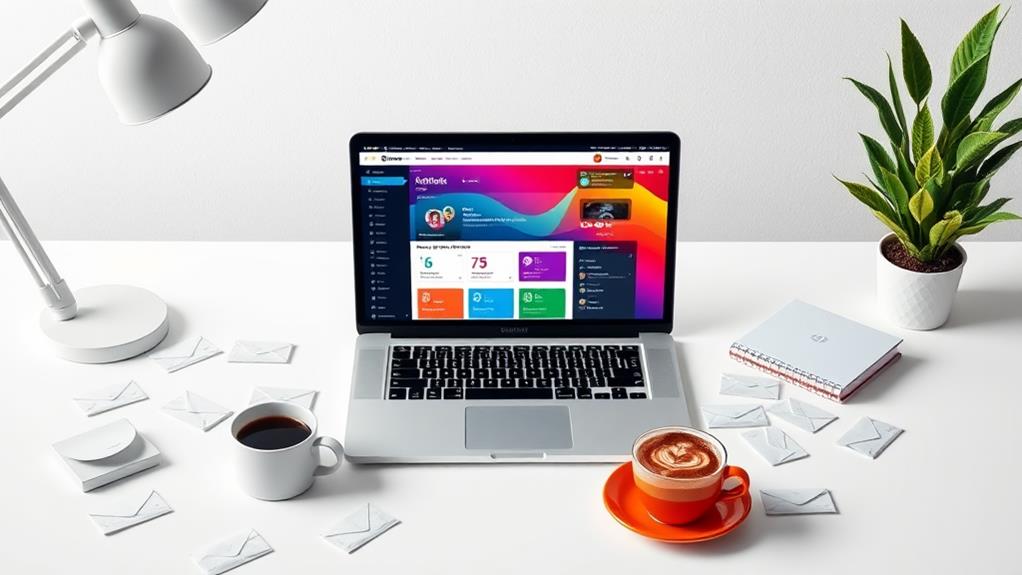Leveraging email automation greatly boosts customer engagement by delivering messages crafted to fit individual behaviors and preferences at ideal times. Engaging content, driven by data, can enhance click-through rates by 14% and conversion rates by 10%. Behavior-triggered emails—such as welcome and abandoned cart reminders—contribute to a 50% increase in engagement. Segmentation allows personalized messaging, achieving 46% higher open rates. Integration of multi-channel strategies further raises engagement with consistent brand messaging. Regular analysis of performance metrics and strategic adjustments guarantee relevance and success. Explore how these insights and tools can redefine your email marketing outcomes.
Key Takeaways
- Implement automated workflows to send timely and relevant messages based on specific user actions and behaviors.
- Personalize email content through audience segmentation to significantly increase open and conversion rates.
- Utilize behavior-triggered emails to deliver personalized content and enhance customer experience.
- Regularly analyze performance metrics to refine strategies and boost engagement rates.
- Ensure mobile-responsive designs and concise subject lines to capture attention and improve open rates.
Understanding Email Automation Basics
Email automation is a transformative tool that streamlines marketing workflows, enabling businesses to deliver timely and relevant messages with minimal manual effort. At its core, email automation fundamentals revolve around the creation of automated workflows that react to specific user actions, such as sign-ups or purchases. This guarantees that messages reach customers at ideal engagement points, markedly boosting interaction rates.
On average, businesses adopting these strategies experience a 50% increase in engagement, an endorsement to the power of workflow efficiency.
The widespread adoption of email automation is evident, with 71% of B2B marketing professionals utilizing it to enhance communication and improve process efficiencies. The ability to automate responses and send targeted messages not only conserves resources but also raises conversion rates, making it an indispensable asset in modern marketing arsenals.
Automated workflows serve as the backbone of these systems, seamlessly integrating with customer journeys to deliver pertinent content.
To maximize the benefits of email automation, regular monitoring of performance metrics such as open rates and click-through rates is essential. This ongoing analysis allows businesses to refine their strategies, guaranteeing that they continuously engage customers and drive desired outcomes.
Personalization Through Segmentation
Building on the efficiencies gained through email automation, personalization through segmentation emerges as a powerful strategy to further enhance customer engagement. Segmenting email lists based on behavioral insights can lead to a remarkable 760% increase in revenue, underscoring the impact of targeted communication.
By analyzing audience preferences, businesses can deliver personalized emails that incorporate the recipient's name and specific interests, improving click-through rates by 14% and conversion rates by 10%.
Utilizing integrated data from CRM, e-commerce, and social media platforms enables marketers to finely segment their audiences, crafting messages that resonate deeply with individual consumers. This approach guarantees that content is not only relevant but also compelling, driving higher engagement.
In fact, segmented automated emails boast 46% higher open rates compared to traditional, non-targeted messages, highlighting the effectiveness of this strategy.
Moreover, regularly updating audience segments in response to evolving customer behaviors is essential to maintaining the relevance of communications. By consistently aligning messaging with individual preferences, businesses can foster stronger connections with their customers.
Consequently, leveraging personalization through segmentation, powered by behavioral insights, is indispensable for any brand aiming to raise its email marketing efforts.
Timing and Behavioral Triggers
Strategically optimizing the timing of email dispatches greatly enhances engagement, as studies reveal that emails sent on Tuesdays and Thursdays around 10 AM align with peak interest periods. This ideal sending strategy can greatly boost engagement rates, making certain that your message reaches your audience when they are most receptive.
In addition, integrating trigger strategies based on user behavior, such as product page views or cart additions, enables businesses to capitalize on timely follow-up opportunities. Research indicates that these automated, behavior-triggered emails can increase engagement rates by 50% on average.
To maximize the effectiveness of these strategies, it is essential to employ real-time behavioral triggers that deliver personalized content. This approach not only nurtures deeper customer connections but also enhances the overall customer experience. For instance, cart abandonment reminders, triggered at the right moment, can result in a 22% uplift in sales.
However, it is important to exercise caution with frequency. A/B testing is a critical tool in determining the ideal frequency, as excessive emailing can lead to a 69% unsubscribe rate. Striking the right balance with 1-4 emails per month ensures sustained engagement without overwhelming your audience.
Designing Engaging Email Content
Crafting compelling email content is an art that combines creativity with data-driven insights to captivate and engage recipients effectively. To maximize engagement, it's essential to optimize your email templates for mobile responsiveness, considering that 46% of all email opens occur on mobile devices.
Responsive design guarantees that content remains accessible and visually appealing across various platforms, enhancing user experience.
Prioritizing content placement through a well-structured visual hierarchy is imperative. Important information should be placed above the fold to immediately capture attention, as this strategy can notably boost engagement rates.
Engaging visuals are equally important; incorporating them can raise email engagement by 42%, making your content more attractive and shareable.
Subject line strategies also play a significant role; crafting concise subject lines with 6-10 words can lead to higher open rates by drawing more recipient attention.
Finally, integrating clear and compelling CTAs is critical. These CTAs guide users toward desired actions, greatly improving click-through rates.
Integrating Multi-Channel Strategies
Integrating multi-channel strategies is essential for enhancing customer engagement, as it guarantees a cohesive experience across platforms like SMS, social media, and email.
By synchronizing communication channels and implementing cross-platform engagement tactics, brands can personalize interactions, leading to a 70% consumer preference for such messaging and a 30% boost in retention rates.
Furthermore, unified brand messaging across these channels not only increases email open rates by 20% but also drives a significant 760% increase in revenue through targeted audience segmentation.
Cross-Platform Engagement Tactics
Harnessing the power of cross-platform engagement tactics is essential for businesses seeking to enhance customer interactions and drive results. By leveraging cross channel synergy, companies can achieve engagement optimization through strategic integration of various communication platforms.
For instance, blending email with social media channels amplifies customer touchpoints, leading to a 30% increase in engagement rates. This synergy not only broadens the reach but also enriches customer experiences.
In addition, incorporating SMS alongside email communications greatly boosts interaction effectiveness as text messages boast a 98% open rate, far surpassing email's average of 21.33%. This prompts more immediate customer responses, enhancing overall engagement.
Moreover, retargeting ads on social media for customers who interact with email content can raise conversion rates by up to 400%, ensuring that messaging is consistent and persuasive across platforms.
Additionally, multi-channel campaigns, such as sending abandoned cart reminders via SMS or social media, can uplift recovery rates, potentially increasing sales by 22%.
Coordinating email and direct mail further solidifies a cohesive brand narrative, with 45% of customers more likely to engage when they experience seamless cross-platform interactions. This approach not only strengthens customer loyalty but also optimizes marketing outcomes.
Synchronizing Communication Channels
Effective synchronization of communication channels is pivotal for brands aiming to maximize customer engagement and conversion rates. By integrating email marketing with SMS and social media, companies can create channel synergy that resonates with the 68% of consumers who prefer a unified communication strategy.
This alignment not only enhances customer experience but also reinforces brand identity, with consistent messaging improving customer recognition and loyalty.
Leveraging cross-channel campaigns allows businesses to follow up with customers based on their email interactions, potentially increasing conversion rates by 20%. Timely and relevant content alignment across platforms guarantees that consumers receive the information they need when they need it, thereby enhancing engagement.
Furthermore, utilizing customer data from various channels enables precise audience segmentation. This targeted approach can lead to a staggering 760% increase in revenue from email campaigns, highlighting the importance of data-driven strategies.
Coordinating email communications with social media engagements can further boost engagement rates by up to 50%. This seamless customer experience underscores the significance of a well-orchestrated multi-channel strategy.
Ultimately, effective synchronization of communication channels not only drives engagement but also fosters long-term customer relationships, positioning brands for sustained success.
Unified Brand Messaging Strategies
How can brands guarantee their messaging resonates across multiple platforms? Confirming brand consistency and messaging alignment is critical for engaging today's interconnected customers. Integrating multi-channel strategies creates a cohesive brand experience, as 72% of consumers express a preference for receiving promotional content via email. When messaging is synchronized across platforms, brand recognition is enhanced, potentially increasing revenue by up to 23%.
A unified strategy facilitates personalized communications. By leveraging extensive customer insights, email campaigns can become highly targeted, yielding a striking 760% increase in revenue. Automation tools are indispensable in this situation, offering the ability to craft timely, relevant follow-ups based on customer interactions. Sending messages when customers are most receptive, such as after adding items to their cart, can greatly boost engagement.
| Channel | Strategy | Impact |
|---|---|---|
| Personalized Campaigns | 760% Revenue Increase | |
| Social Media | Consistent Branding | Enhanced Recognition |
| E-commerce | Timely Follow-Ups | Improved Engagement |
| Mobile Apps | Data-Driven Messaging | Optimized User Experience |
| In-Store | Unified Promotions | Cohesive Customer Journey |
Regular performance analysis is essential. With 39% of marketers prioritizing ROI tracking, ongoing evaluation confirms that messaging remains aligned and effective across channels.
Analyzing Performance Metrics
Analyzing performance metrics is pivotal for enhancing email engagement, as key indicators like open rates, click-through rates, and conversion rates provide actionable insights into campaign effectiveness.
By leveraging data-driven strategies such as A/B testing and segmentation, marketers can greatly boost engagement rates, evidenced by the 46% higher open rates seen in segmented campaigns.
In addition, tracking return on investment, which averages $36 to $42 per dollar spent on email marketing, highlights the necessity of continuous performance analysis to refine strategies and maximize returns.
Key Metrics Overview
To optimize email marketing efforts, understanding and analyzing key performance metrics is vital for evaluating and enhancing customer engagement. Open rates are a fundamental metric, with the industry average standing at 21.33%, offering insight into initial engagement levels. Automated email strategies can greatly boost these rates, with segmented emails achieving 46% higher engagement than traditional methods. Click-throughs are pivotal for gauging how effectively emails channel traffic to your site, forming the backbone of effective conversion strategies. In this situation, email automation can enhance conversion rates by 14%, highlighting its efficacy through tailored messaging.
Monitoring unsubscribe trends is essential for frequency management, as 69% of users cite excessive emails as a reason for unsubscribing. This insight underscores the importance of balancing engagement frequency with content relevance. ROI analysis remains indispensable, considering email marketing's impressive average ROI of $36 to $42 for every dollar spent, showcasing its potential in revenue generation.
| Metric | Average Rate/Stat | Impact on Engagement |
|---|---|---|
| Open Rates | 21.33% | Gauges initial engagement levels |
| Click-through Rates | 46% higher (segmented) | Drives traffic and conversion |
| Unsubscribe Trends | 69% (frequency issue) | Guides frequency and content strategy |
Optimizing Engagement Rates
Harnessing the power of data is vital in optimizing engagement rates for email marketing campaigns. Regular analysis of key performance metrics like open rates, click-through rates (CTR), and conversion rates allows marketers to identify trends and make informed adjustments to enhance effectiveness.
Implementing A/B testing for subject lines and content variations serves as a potent engagement rate booster. Segmented automated emails, which have demonstrated a 46% higher open rate than traditional messages, underscore the significance of tailored content in maximizing engagement.
Comprehensive analytics tools are invaluable in tracking the success of automated email workflows. This real-time data enables marketers to refine list management strategies, guaranteeing emails are both engaging and relevant.
Monitoring unsubscribe rates and customer feedback is essential to adjust email frequency and content, maintaining their value to recipients.
A critical component of list management strategies is maintaining a clean email list by regularly removing inactive subscribers. This practice not only enhances deliverability but also improves engagement rates, leading to an increased return on investment (ROI) for campaigns.
Data-Driven Strategy Refinement
Many marketers recognize that effective email campaigns hinge on a data-driven strategy refinement. By conducting regular data analysis of open rates, click-through rates, and conversion rates, marketers can discern the effectiveness of their email strategies, enabling precise performance improvement. Implementing A/B testing, for instance, can greatly enhance engagement, with personalized emails increasing customer interaction by 74%. This highlights the immense potential of data in refining strategies.
Utilizing advanced analytics tools, marketers can monitor user behavior and preferences, facilitating data-driven segmentation and targeted messaging. Such tactics have been proven to boost open rates by 46%, underscoring the power of tailored communication. Additionally, continuous performance monitoring can uncover ideal sending times and frequencies, addressing the critical issue that 69% of users unsubscribe due to email overload.
| Metric | Strategy | Improvement |
|---|---|---|
| Open Rate | Targeted Messaging | +46% |
| Click-Through Rate | Personalized Content | +74% Engagement |
| Conversion Rate | A/B Testing | Enhanced Performance |
Feedback from customer interactions provides valuable data points, ensuring that email campaigns remain relevant and aligned with evolving audience needs. By leveraging these insights, marketers can craft more effective, engaging messages, achieving sustained customer engagement and loyalty.
Frequently Asked Questions
How Do You Automate Emails to Customers?
To automate emails to customers effectively, implement email triggers based on user actions and employ segmentation strategies to tailor content. This approach enhances engagement by delivering personalized, timely messages, which can greatly boost conversion rates and customer satisfaction.
How Do You Automate Customer Engagement?
Automate customer engagement by leveraging customer behavior insights and engagement metrics. Implement tailored workflows that trigger personalized communications, enhancing interaction and conversion rates. Regular analysis of these metrics guarantees strategies are refined and communications remain impactful and relevant.
How to Increase Customer Engagement in Email Marketing?
To increase customer engagement in email marketing, implement personalized content and utilize segmentation strategies. These approaches, supported by data, enhance relevance and targeting, driving higher click-through and conversion rates, and greatly boosting overall customer interaction and satisfaction.
How Do I Optimize Email Automation?
To optimize email automation, implement email segmentation strategies and personalized content techniques, leveraging data-driven insights. Tailor messages to audience preferences, refine timing, and enhance engagement through continuous A/B testing and performance tracking for maximized outcomes.
Conclusion
The integration of automation in email marketing greatly enhances customer engagement by leveraging segmentation for personalization, optimizing timing through behavioral triggers, and crafting compelling content. Moreover, the incorporation of multi-channel strategies guarantees a cohesive customer experience, while the analysis of performance metrics provides actionable insights for continuous improvement. By systematically applying these strategies, organizations can achieve higher engagement rates, foster customer loyalty, and ultimately drive business growth through more effective and efficient communication practices.




